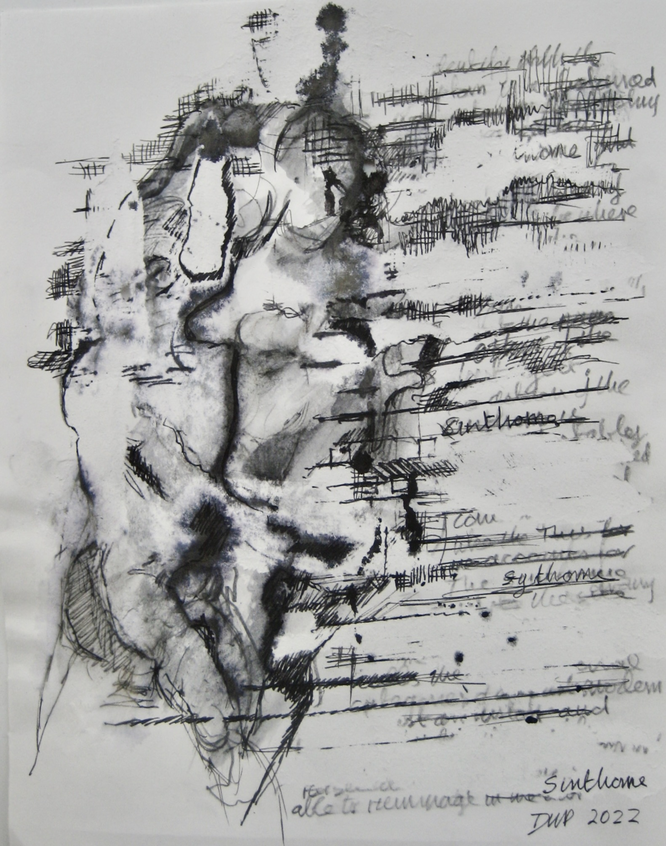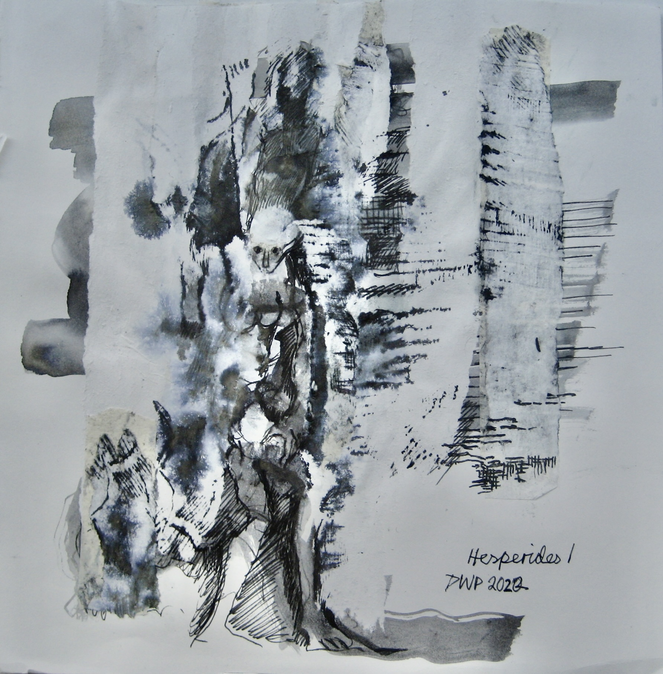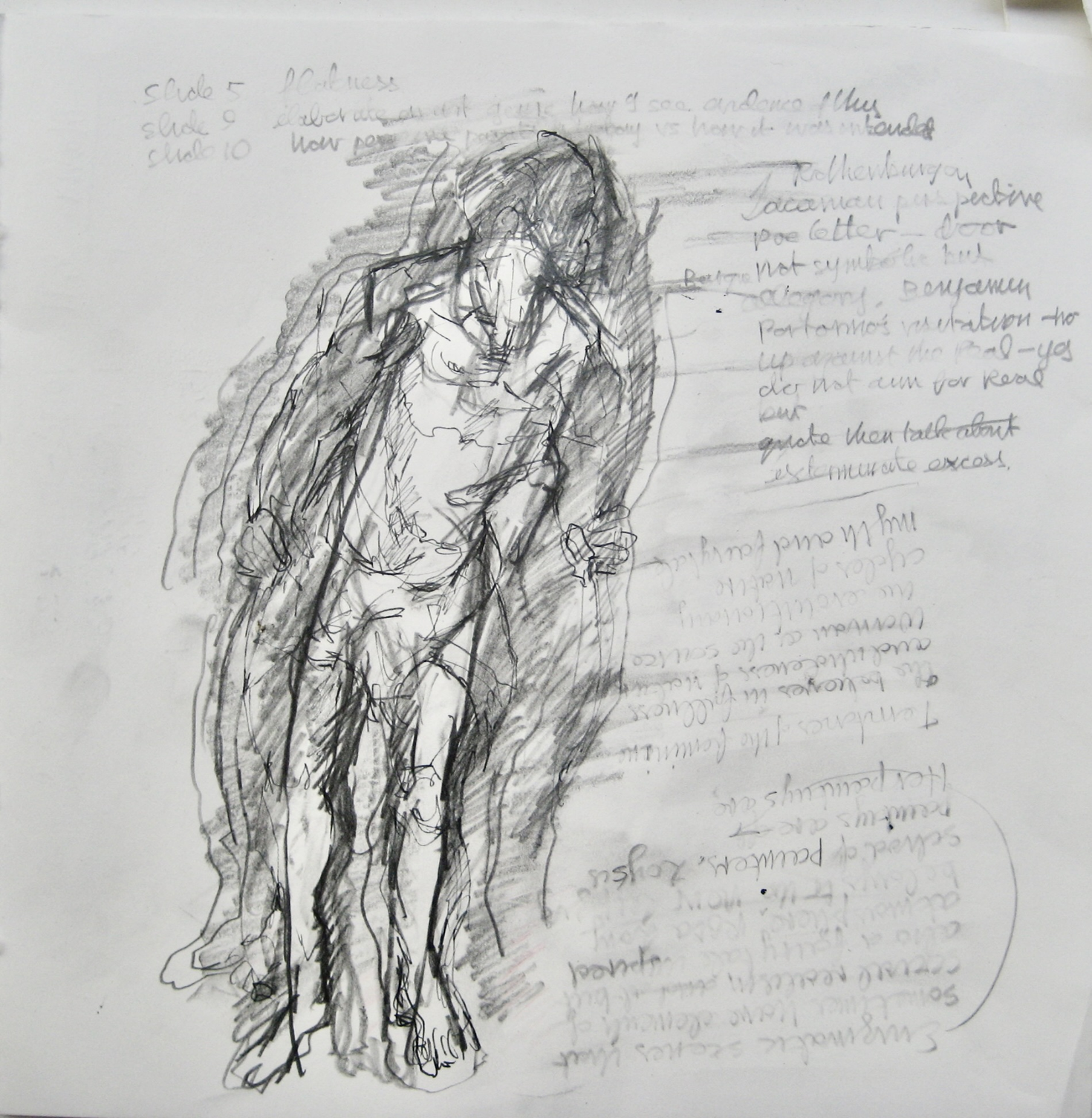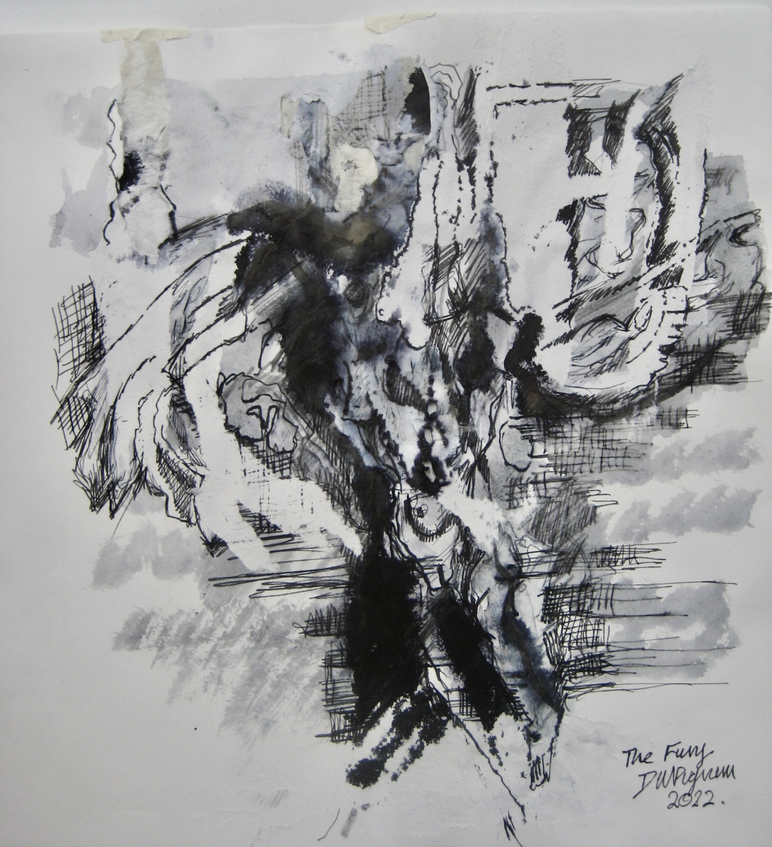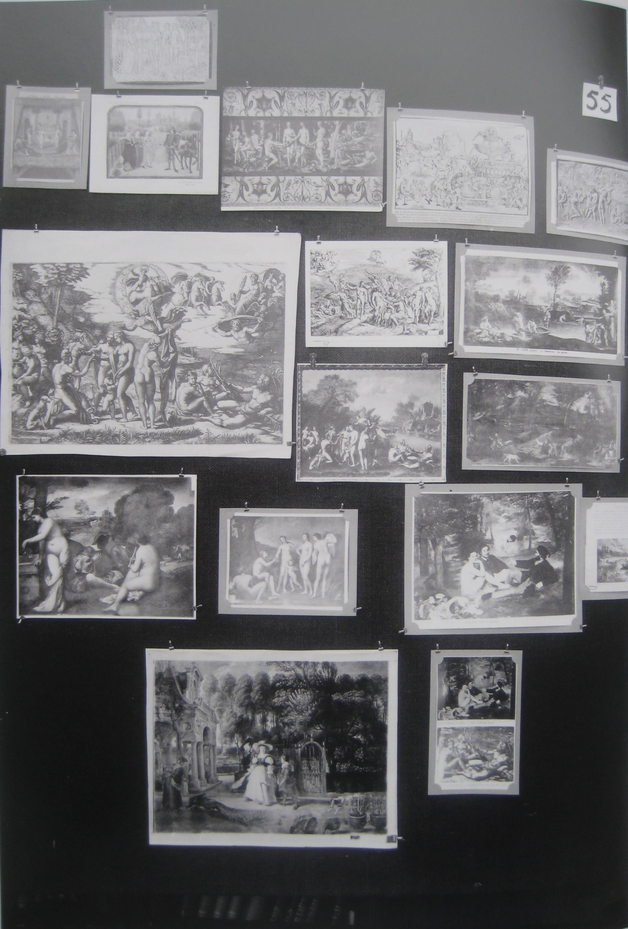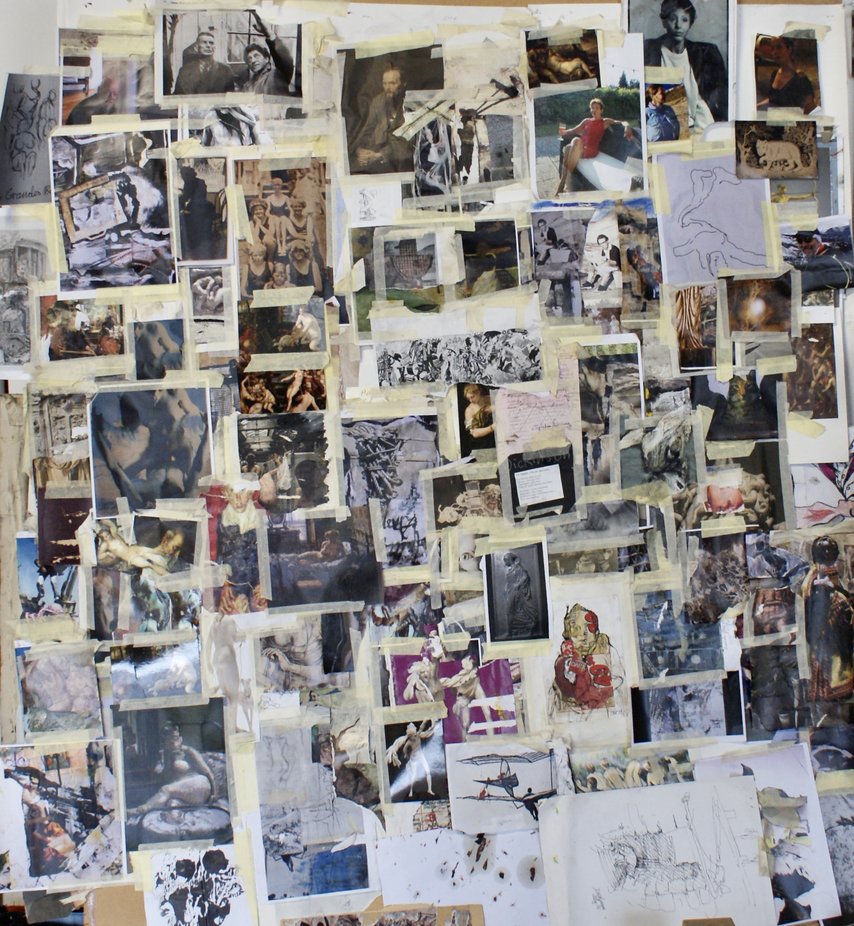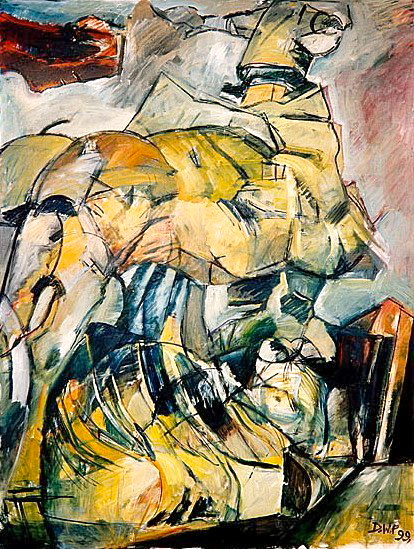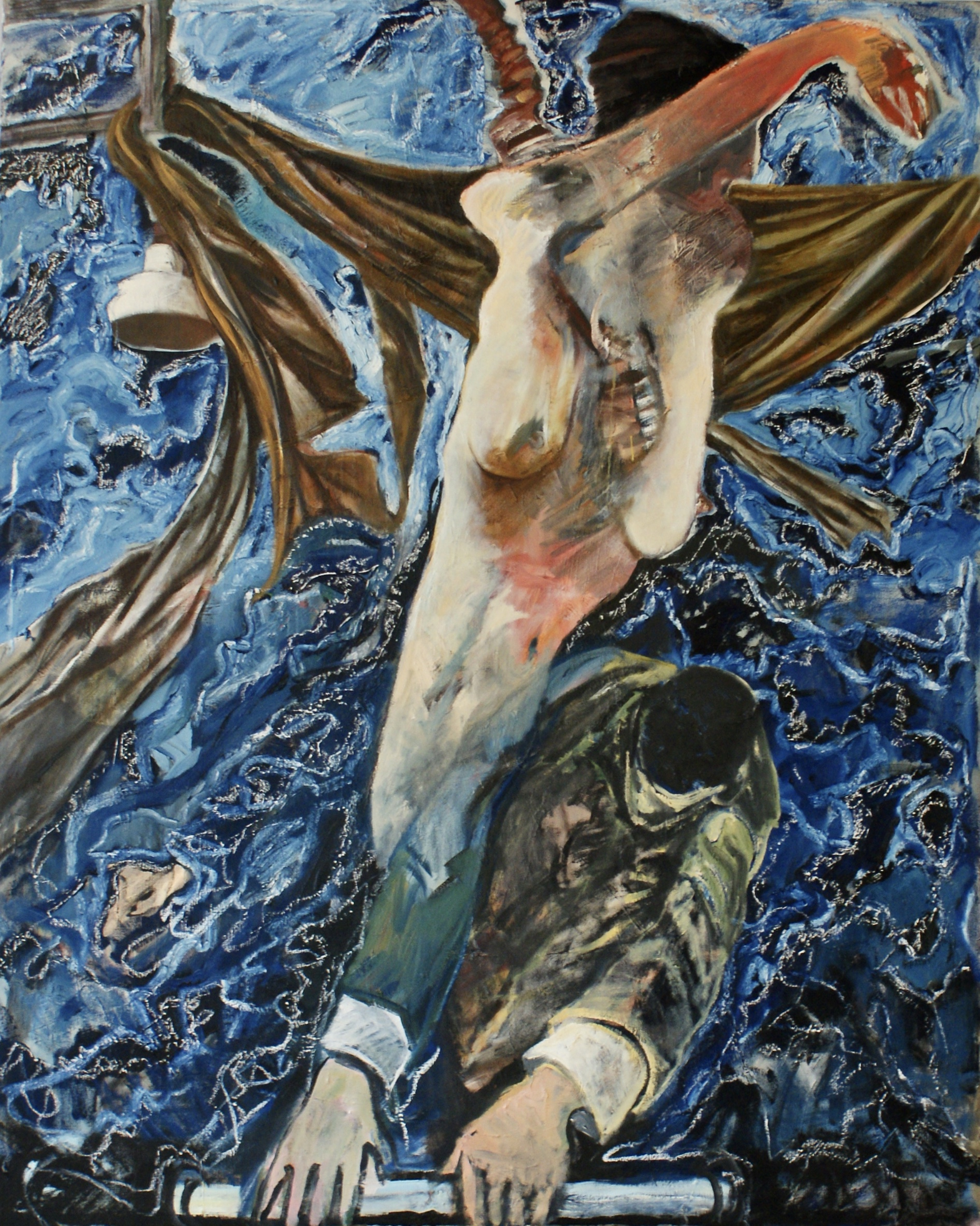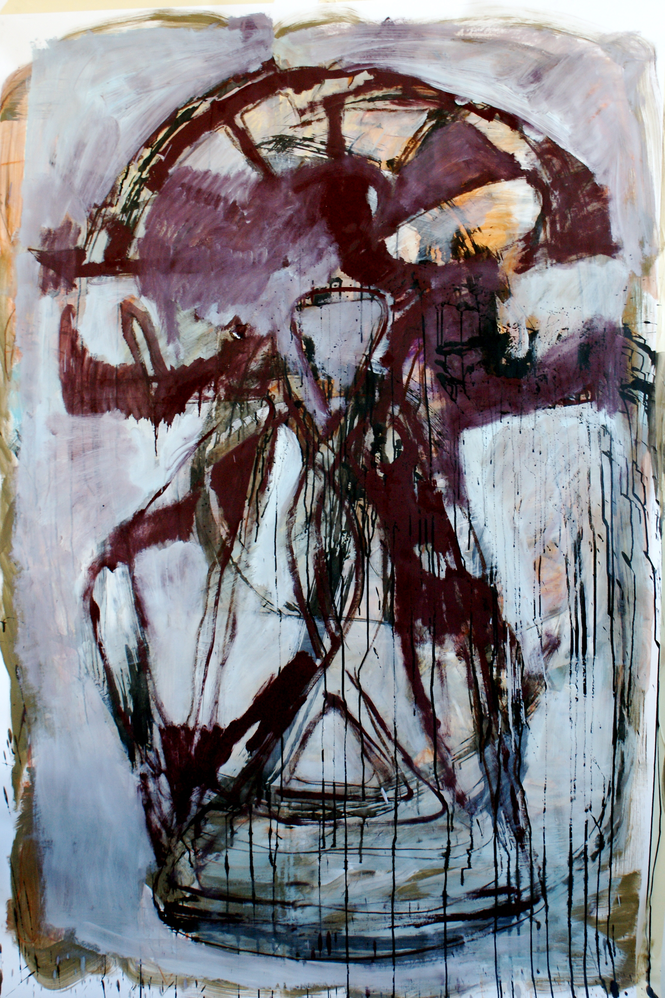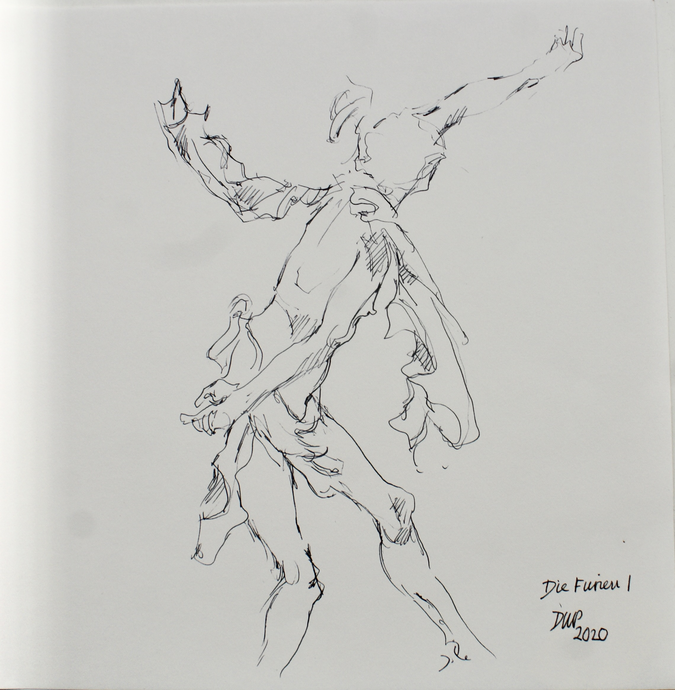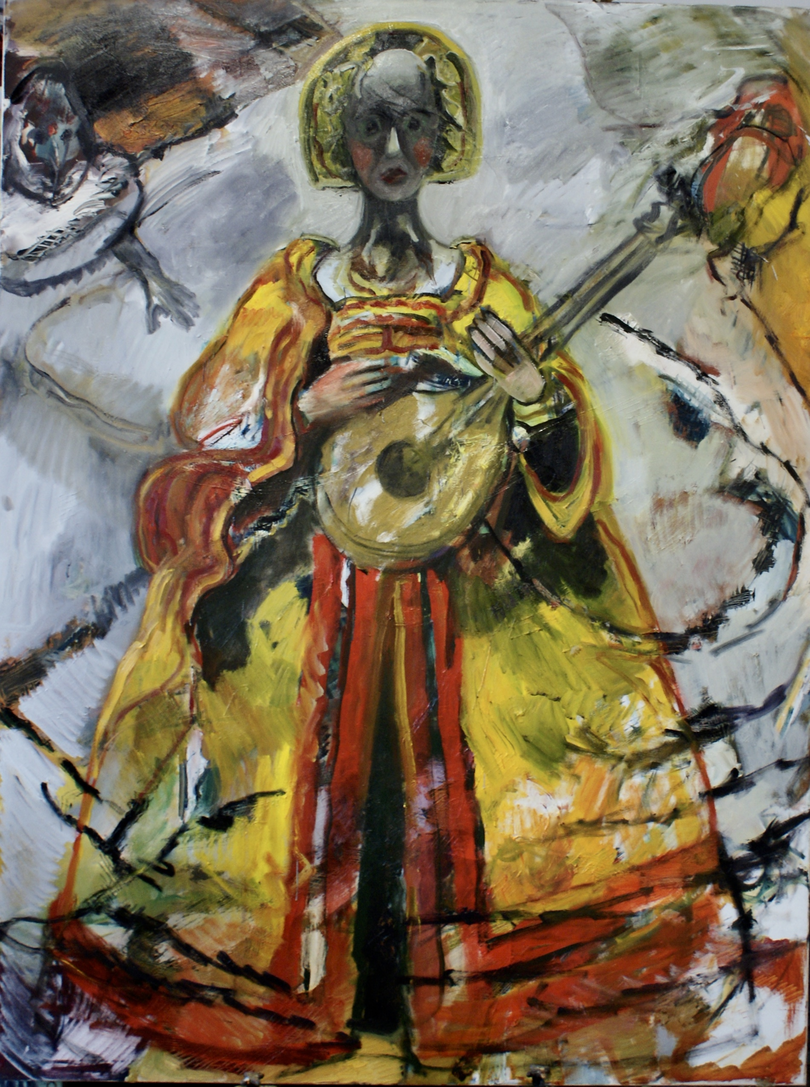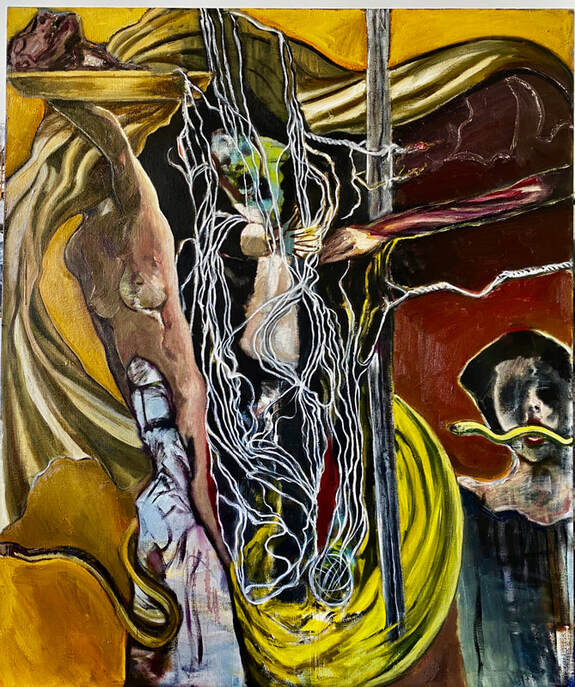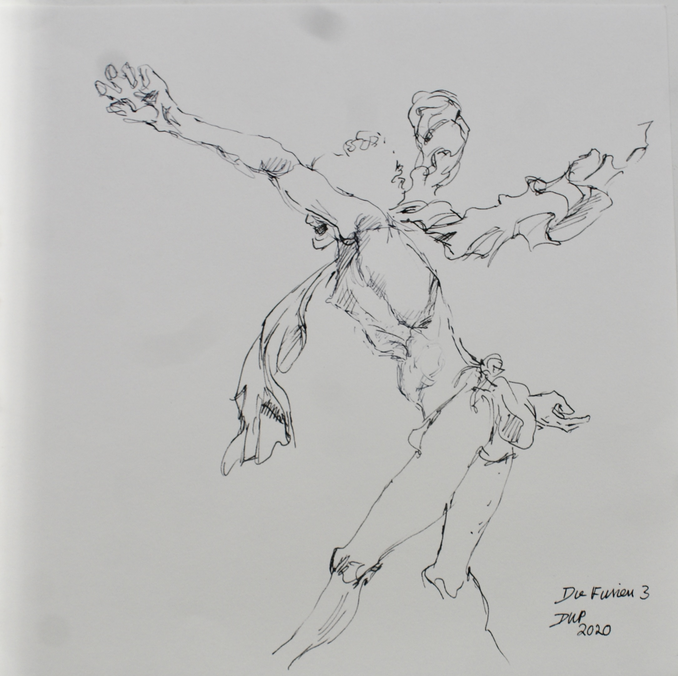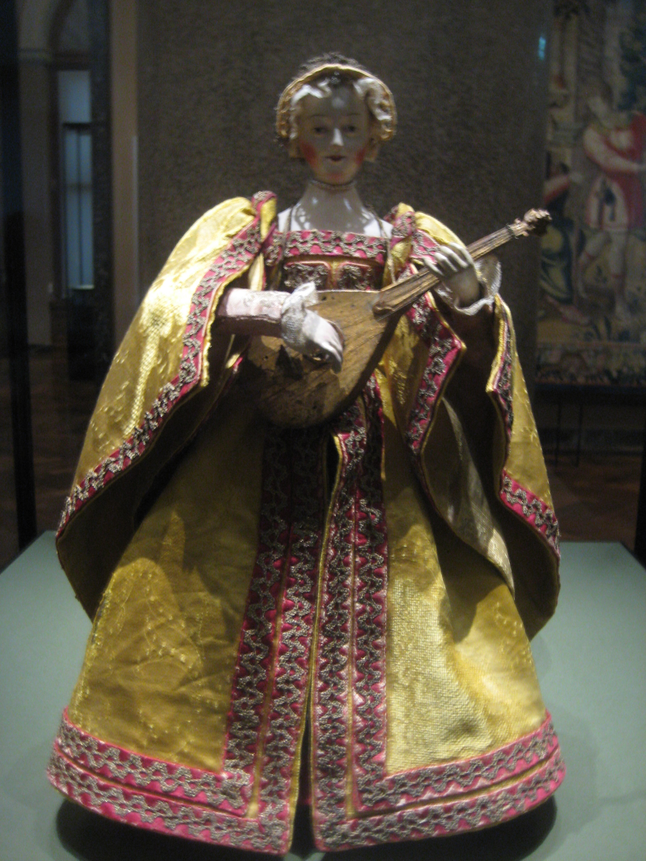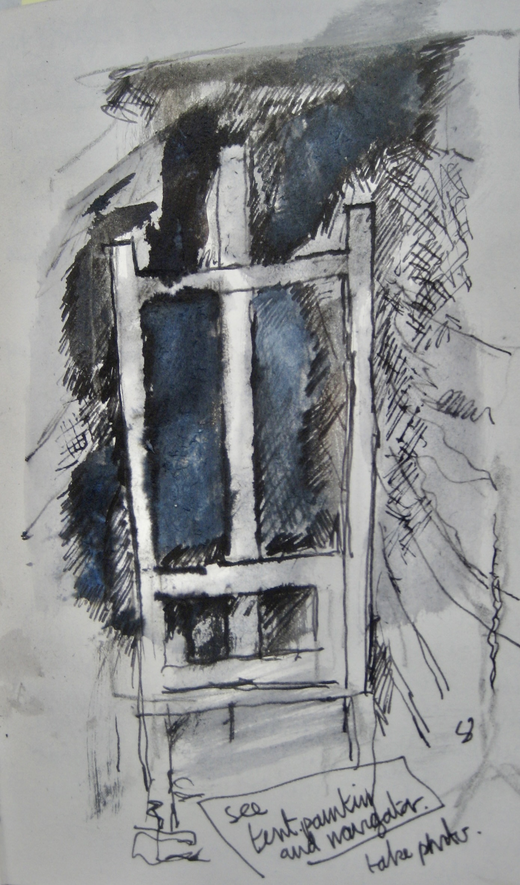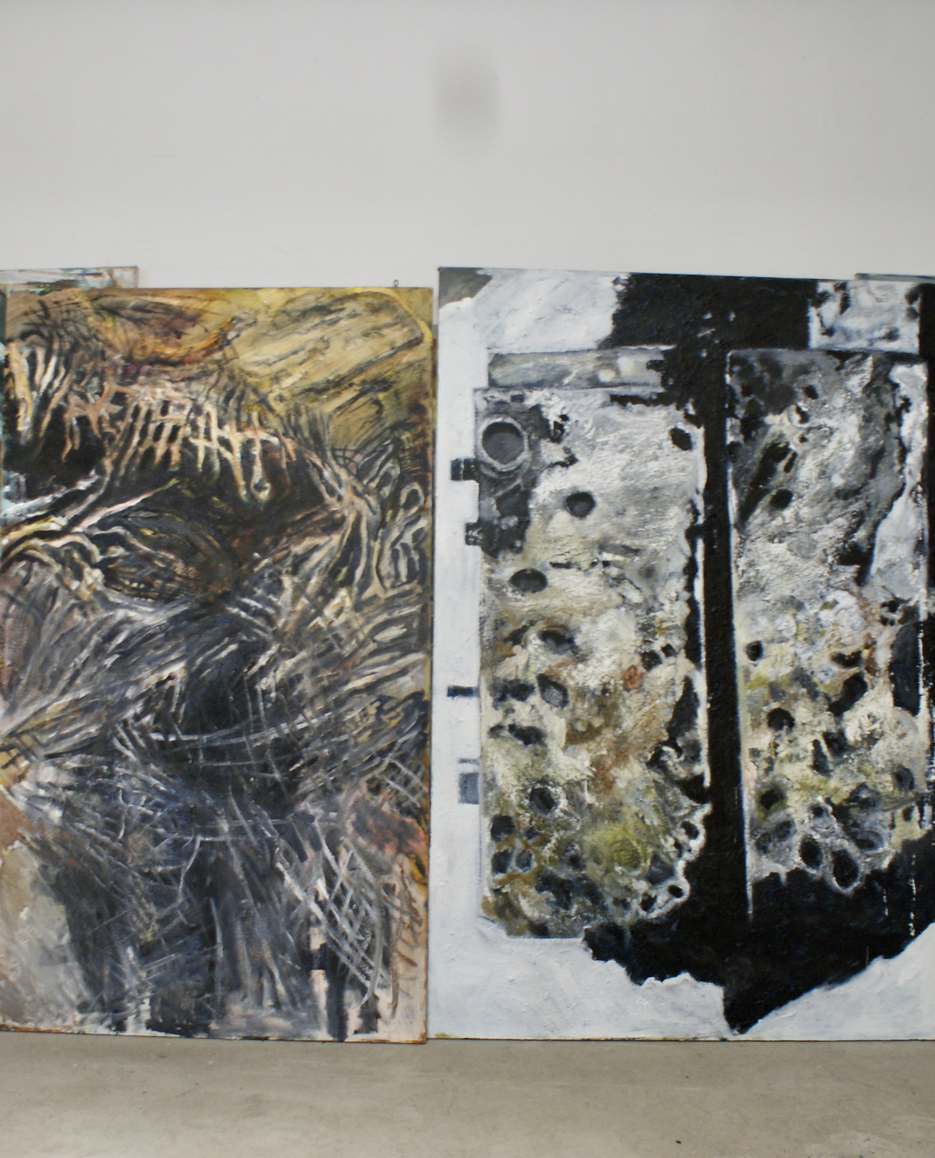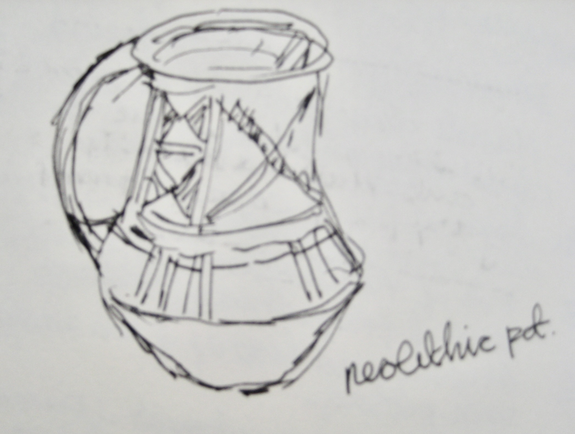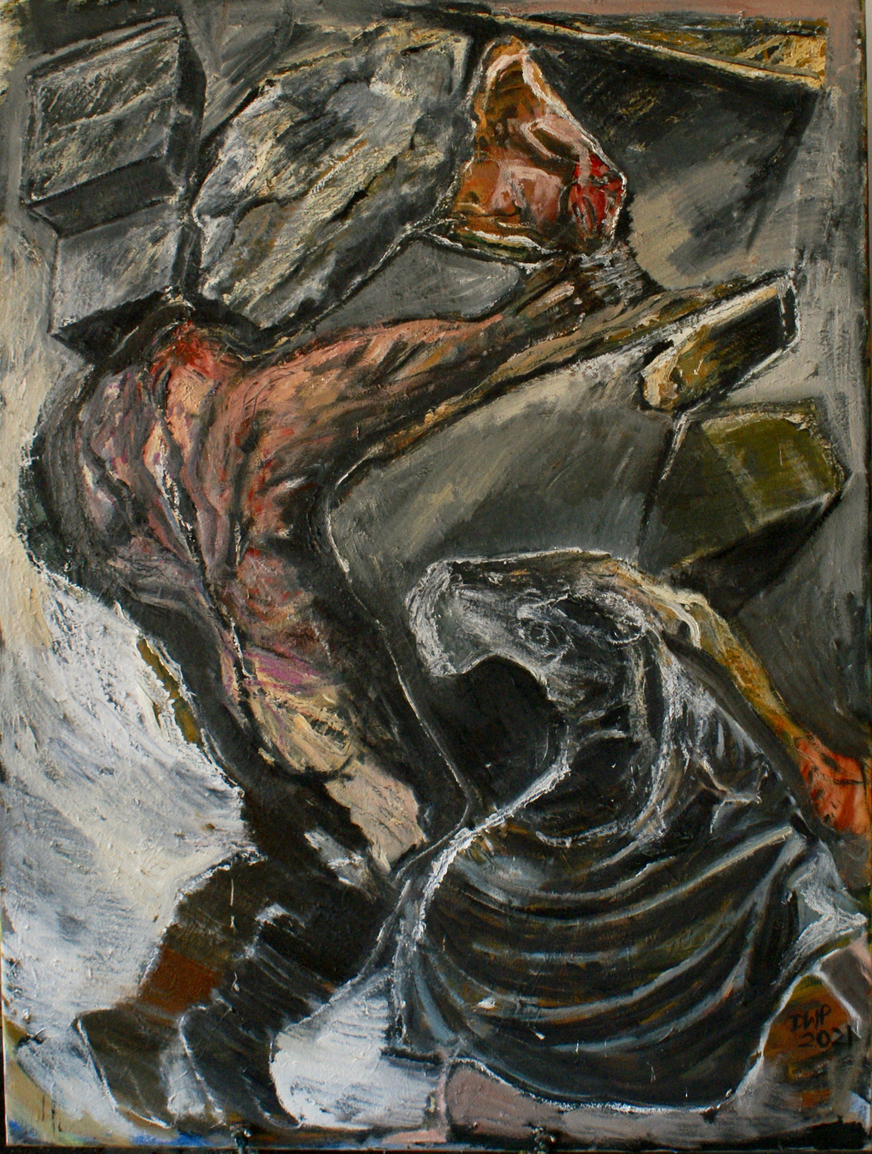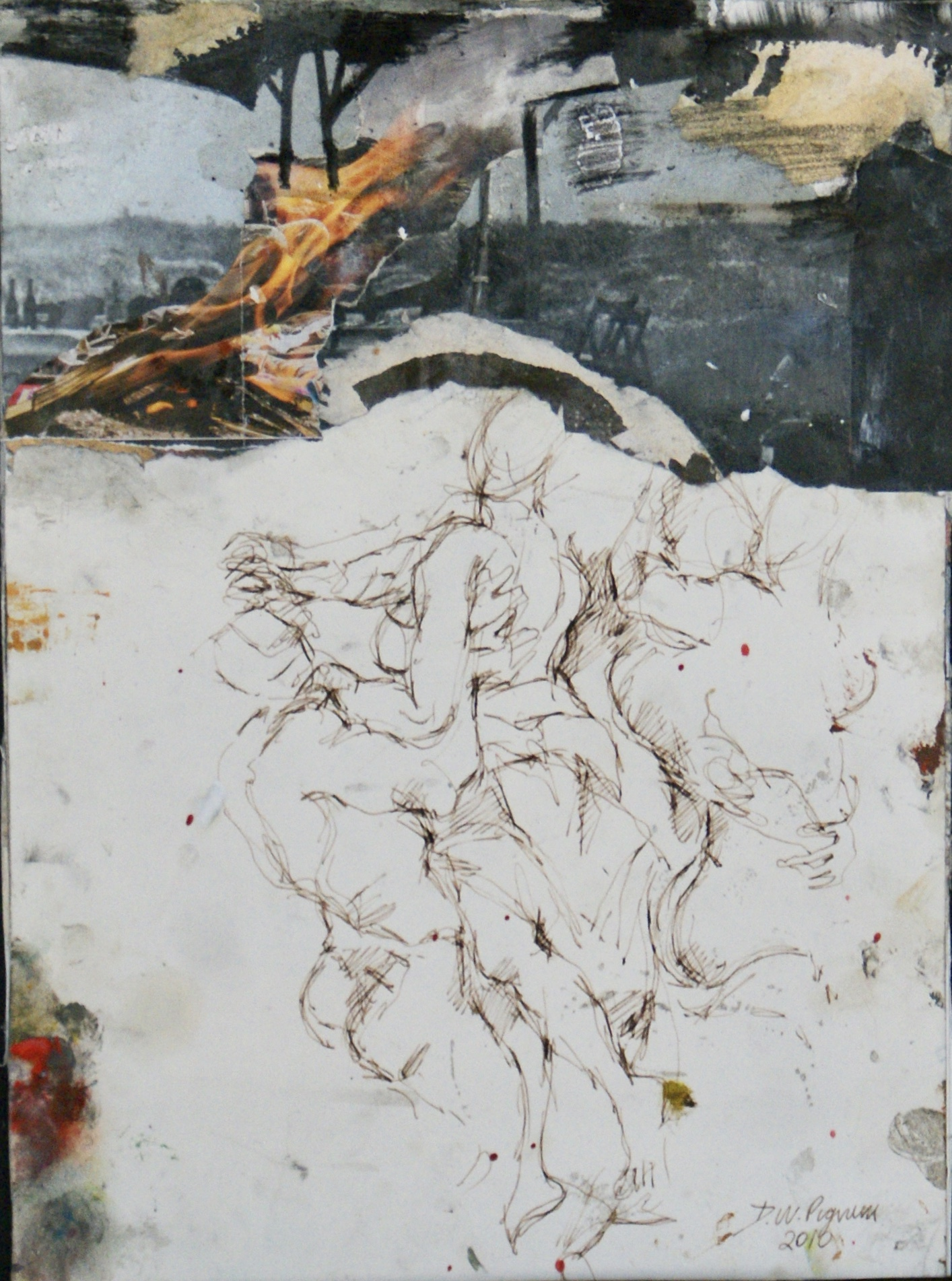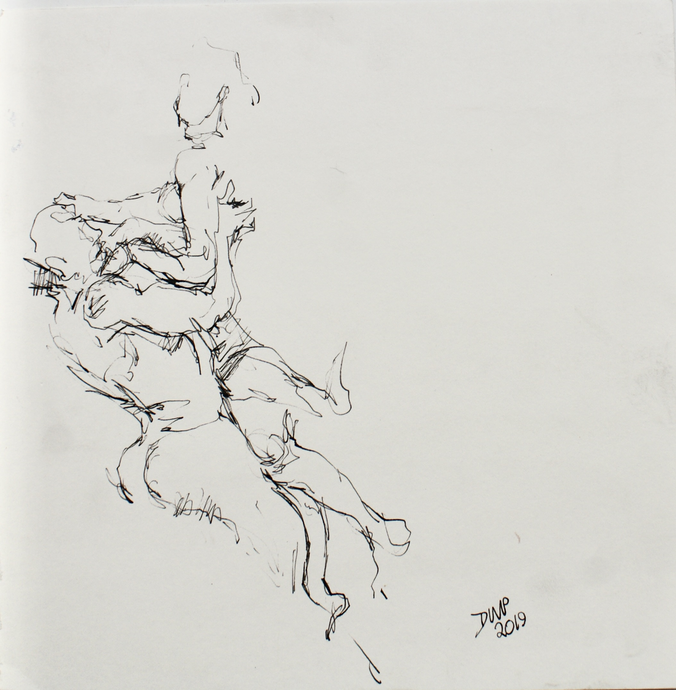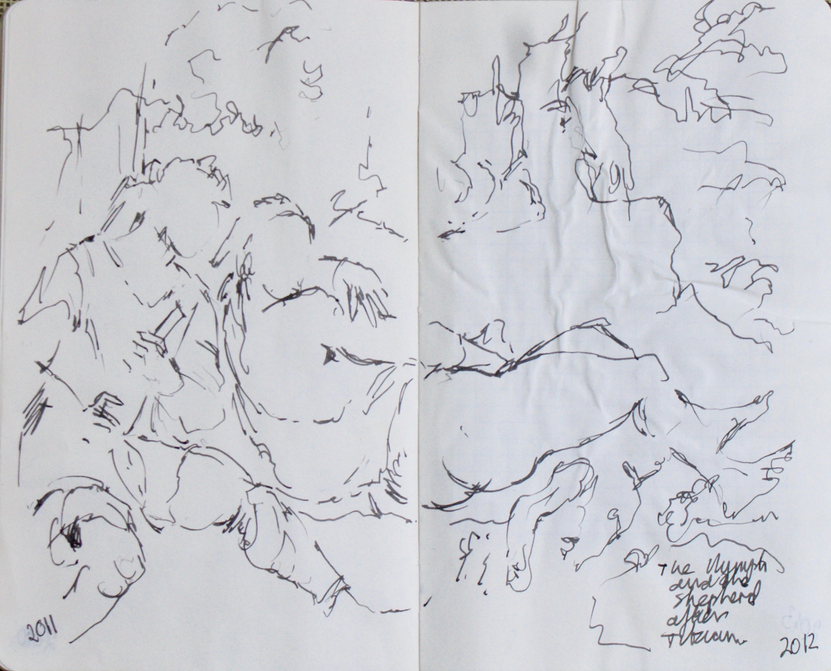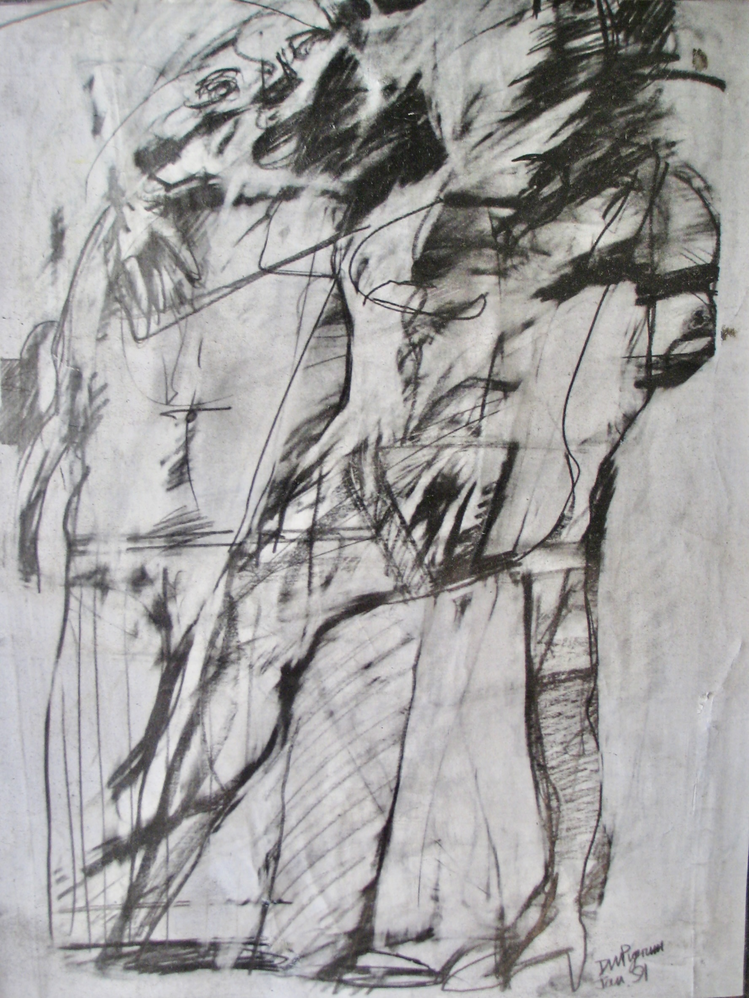Intimate to and transcendent of transient time qua the seen and drawn in the present: an email to a painter/academic and his reaction
Note on the Exposition's Format:
By clicking on Return to Top... at the base of each page, begining with this Title page, this takes the viewer/reader to the top of the next page chronologically, etc., through to Return to Top 11, which brings one back to this present page. Such a return to the beginning suggests ellipticality, which keys into ideas expressed of time in the exposition. The final Return to Top 12 takes one back to the Postscript page and hence the end of the exposition.
The exposition content is conveyed mainly as a dated email exchange, with several additional exchanges named as dated interventions. The ostensibly first intervention that the viewer/reader encounters, on this Title page, is, according to its date, actually the last, of which the purpose is to introduce one of the two participants' most recent drawings.
Email Intervention Pigrum, 11 Dec. 22
Something happened yesterday that began months ago that may have relevance to what we are putting together. I have drawings done in the museum that I rejected and used to write on in the work I have with students. Then one day I began to elaborate on one a little more with a pencil this is the first drawing attached (Figure 23). Yesterday evening I unexpectedly went one step further and using ink pencil and masking tape transformed four of these drawings in the way shown (Figures 24 - 8). I flayed off the surface of the drawing having first applied ink and pencil and used the tape on the reverse side of two drawings and these are the final two pictures. I may continue with this until I have used up all the rejected drawings and then see. What it made me realise is how much I would love to learn etching.
Figures 24 - 8: Top left/right: Sinthome, 22.5x 29cm, Fury; lower left/right: Hesperides 1, Hesperides II, each 29 x29 cm Ⓒ Derek Pigrum
While websites such as Academia and ResearchGate promote publications of academic research, the Research Catalogue (RC) enables one to present and/or formally publish one’s artistic research. The artist/authors of the present exposition, Derek Pigrum and Mike Croft, have been using the academic websites for several years, Croft has published several expositions already on the RC, and this is Pigrum’s first venture on the RC as a co-author. Both artist/authors participate in a research project called ‘The Observation of Perception, considered through drawing’, hosted by i2ADS – Research Institute in Design and Society, the present exposition of which is a consequence of on-going discussion between five artists, and in the present instance between Pigrum and Croft.
These artist/authors first made each other’s acquaintance in the discussion on Academia in May 2021, and have maintained substantial email correspondence ever since. Pigrum more recently became a ‘collaborative researcher’ with i2ADS and has joined the ‘Observation of Perception…’ group. Both artist/authors are, in their capacity as artists, figurative painters, while Croft now focuses mainly on what Pigrum, following a consideration of his PhD study, would call transitional multimodal drawing. Pigrum paints and draws in a sense that greatly respects tradition, following T. S. Eliot’s idea of the indissoluble relationship between tradition and innovation, and reflects on and articulates his creative practice through academic publications. Croft currently explores the question of one’s automatic subjective positioning within one’s practice through combinations of drawing, speech and its transcription, video, and academic writing. This distinction aside, these artist/authors confer in many ways through mutual interests in philosophy and psychoanalytical theories that both support and further their respective practices.
Email Intervention Pigrum, 5 Dec. 22
My only reservation is the title (‘The past… ‘re-visited and reshuffled…’). If possible I would like to convey a sense that the things I draw from, that I translate into drawing, just as one translates something from another language into one’s own language, are not in a distant past, in some sense not in the past at all. The things I draw are intimate to time but at the same time transcendent to time in all its transience. The gap between now and then shrinks in offering themselves to be seen and drawn. So they seem to me to always be wholly in the present. This is very difficult to for me to formulate but these things give way as I draw them and in doing so make a way, become porous to the present. They are then not at all remote but fully of the now.
I was thinking of you this-morning as I came across a little more from Lacan on the automaton. If you remember, when I recently mentioned some reading on this it was from the 1964 seminar of Lacan, where he uses the automaton as a metaphor for the repetition of certain chance encounters that, because of their coincidences, are of significance to psychoanalysis. Lacan (2018, p.38) talks here about 'discourse', specifically that of an analysis – which, I wonder, may be close to what goes on as the dialogue between oneself and one's creative practice? Of such a discourse, he states that 'its meaning remains veiled', and, similarly to what he says of signifiers, merely 'receives its meaning from another discourse'. I think I can go along with this; that the issues within one's work or project merely generate, either directly or indirectly, the issues for the next. Then of 'necessity', he states that such a thing can only begin with a 'speaking being' and involves 'the doing of a discourse'. Then he refers to the necessity 'of the labour of actualising' the necessity. It seems that somehow or other, once the circumstances are set in motion, for which the automaton is the metaphor for one's 'symptom', it's automatically a matter of repeating it. This understanding of necessity is useful to me because I'm still struggling with Lacan's version of Aristotle’s original logical square, on which, on a variant of the square in his Seminar XIX, Lacan (2018, p.186) places the word necessary at the top left corner. It's tempting to think of this as the starting-point of reading the movement around the square, but it's not; it seems to be the place where what Lacan (2018, p.185) terms 'what necessitates existence' orientates. Where one enters the square I think depends on context. This corner, necessary, may have its origin with Freud's theory of the Oedipus complex. However, within this difficult theory there is this arguably compulsive idea of searching for what's been symbolically lost, which fuels desire. The repetition is then the repeating of whatever is the psychic symptom, the stand-in for what has been lost, the lost object, retrospectively. There's something here about 'bricolage', which I think might be a way in, so avoiding the specificity of the psychoanalytic context:
It occurs to me that maybe when we refer to meaning, a better term would perhaps be sense. Lacan distinguishes between meaning as that which is, as he puts it, 'caught between signifiers', and sense, which he terms 'the formal structural framework of the signifiers'. So 'ab-sense' is not what's missing, so much as what breaks down. It's a subtle difference, but would allow us to maintain some tenuous connection, as opposed to ceasing being able to identify, when lack of meaning occurs. Put another way, Lacan figures the usual movement as from the empty signifier, the Other, to the chain of signifiers that it generates, whereas with ab-sense the movement has broken down, as if the chain of signifiers is then looking for the missing main signifier. I do wonder: is this what might be meant by having been forced, by the work itself, to let go of it? Somehow I feel this question of ab-sense relates to what you suggest is the excess of your subjectivity, which prevents you from being able to retrospectively identify with meaning, as you put it. Meaning would here be whatever it is that's the driving symptom, the necessity, which is also the starting- and motivating point.
Then (Lacan, 2018, p.39) Lacan says: '...by tirelessly repeating this bricolage. This is what is called, at a certain level, the symptom.... At another level, it is automatism'.
When you say this: 'If there is any meaning in my work it resides in those moments when I am in excess of my own subjectivity and therefore inaccessible to retrospective identifying as meaning', I've also come across a term from Lacan that’s new to me: 'ab-sense'.
Badiou, A. (2018) Lacan Antiphilosophy 3 (Trans.Kenneth Reihard; Susan Spitzer) New York: Columbia University Press
Lacan, J. (2018) ...or Worse. The Seminar of Jacques Lacan Book XIX (Ed. Jacques-Alain Miller; Trans. Alan Price) Cambs., UK: Polity Press
'There is a response to this question [of necessity], as there is to any question, due to the reason that it is posed, as is any question, only when one already has the response. You have the response, therefore, even if you don't know it. In response to the question what is necessity? you logically cobble together your bricolage. Even if you don't know it, you respond to your day-to-day bricolage'. (Lacan, 2018, p.39)
Intervention Croft, 1 Dec. 22
According to Badiou (2017, p.50), ‘ab-sense’ is an expression of the impossibility that constitutes the later so-termed real version of the unconscious, of Lacan’s three interlinked psychic structuring registers Real, Symboilic, Imaginary (R-S-I), a synonym of which is more particularly written as ‘ab-sex sense’. This latter meaning is that there is no such thing as a sexual relationship. Badiou states of ab-sense:
‘…it is neither sense nor non-sense but a unique, incongruous, and absolutely original proposition…’
‘…the real as having this absence of sense whereby there’s no such thing as a relationship, a sexual relationship…’
‘…any function of the real in knowledge concerns, in positive terms, absence’. (2017, pp.50-1)
While it’s not an intention of the exposition to explore this particular meaning, it may be helpful to hear of the context in which this unique term ab-sense originated, In order for it then to be taken more generically as absence of meaning itself, which is not reducible to mere nonsense, as a positive factor represented by the hyphen.
The idea of the automation of contingency that generates repetition is extremely interesting. At the same time I realise that I must qualify two things: I have presented contingency as the driving force behind within my practice but this is only part of the story, which indeed your remarks suggest. After the contingent encounter with the exhibition of Warburg's Atlas Mnemosyne (Figure 1) the role of the museum in my practices took on major significance but also generated panels of what I term charged images in the studio (Figure 2). In a detail from the board we see the ivory of the Fury mentioned below in the middle on the left-hand side.
The other qualification connected to this concerns the quote from Agamben about the archaic and contemporaneity. Of course drawing for five years in the Ephesian Museum and then the paintings that followed on of the Artemis Selene were in the order of the transformation of the archaic into something contemporary of which the image of the ‘Imago’ and the ‘The Navigator’ are examples (Figures 3, 4, 5).
However, I have come to realise that this also needs qualifying in terms of what Bruno Latour (1993, p.76) writes in his book 'We Have Never Been Modern', where he writes about the way we actively sort out things belonging to different times and it is 'the sorting that makes the times, not the times that makes the sorting'. Latour sees modernism as a sorting made by a very small group in the name of all, and places the responsibility on each person (artist) to do his own sorting and in this way rediscover our freedom. He writes about the elements we sort as being along a spiral where the past is revisited and reshuffled, where the past sometimes appears nearer to us than an element of the contemporary obliging us to dispense with terms like archaic and advanced. Latour (1993, p.75) writes; 'In such a framework, our actions are recognised at last as poly-temporal' reminding me of my journey through the rooms of the KHM yesterday. Here I first stopped at a Medieval painting to draw an ensemble of hands with no particular use in mind (Figure 6) then moved on to visit and look into the eyes of the 17th century automaton (Figure 7) and from there to the 17th century ivory of the Fury by the unknown 'Master of the Furies', which I had drawn previously and which was incorporated into the painting Fury I (Figure 8).
Latour, B. (1993) We Have never Been Modern. (Trans. Catherine Porter) Cambridge, Massachusetts: Harvard University Press
I then took a photograph of the easel behind which hung a curtain in the side gallery exhibition of the early photography of painting (Figure 12) - the ostensible reason for my visit and the possibility it presented for a continuation of my present work seen in the two paintings in the studio, the painting of 'The Gates' and 'The Curtain' (Figure 13).
Figure 12: Notebook drawing of Easel and Curtain, after a photograph taken in a side gallery of the Art History Museum in Vienna Ⓒ Derek Pigrum
Then to my surprise I found myself before a very ancient relief that narrated the last phase of the Odyssey where Odysseus kills the suitors. The figure of Penelope that stands at the commencement of the frieze reminded me of how important Benjamin's notion of the Penelopewerk, or work of Penelope was for my Ph.D. thesis, the idea of Das Gegenwerk and publications on transitional non-finito drawing practices (Figure 14).
Email intervention Pigrum, 11 Dec. 22
I have attached a diagram in my notebook that plots the four stations of Das Gegenwerk or rather have the quality of the Das Gegenwerk as being both towards and against definitive closure (Figure 22) I do not know if you want to use this. The Penelopewerk is simply the act of doing, undoing and re-doing in terms of multi modality of non-finito drafting processes.
There was also a remarkable sentence in German in the description of the frieze, which talked the bow of Odysseus as having once been depicted in a painting. From here I made my way to some very early Christian paintings on threadbare and stained linen that I registered as a possibility for collage work. Finally on this level I drew a Neolithic pot should I, by some chance, once again have the possibility of working on a potters wheel, something I love (Figure 15). This drawing I associate with one of a number of paintings on Old Testament themes entitled 'The Death of Samson' (Figure 16).
On the floor above, where I normally draw, I simply sat in front of Veronese's painting of the 'Anointment of David' (Figure 17), Titian’s 'Nymph and Shepherd’(Figure 18), and the dancing figures in Ruben’s 'Venus Festival' (Figure 19) that I have drawn from repeatedly. I included a piece of collage into one of these drawings of the dancers (Figure 21), and associate the drawings after Rubens with the drawings of Tango dancers (Figure 20).
I would like to convey a sense that the things I draw from, that I translate into drawing, are not in a distant past and in a very real sense not in the past at all. The gap between now and then shrinks when offering themselves to be seen and drawn. To me they are always wholly in the present. This is very difficult for me to formulate but these things by drawing them become porous to the present. J-L Marion (2002, p.35) states, ‘To stop before the painted surface is not only to question the object of our gaze. It is also to stop before time’. But as Marion (2002, p.71) says, ‘this all goes beyond the aesthetic’. The work gives itself in the lived experience of drawing and strictly speaking never affects me twice in the same way. I see it differently each time I draw it. And each time I draw it confirms that ‘it will never be a closed object exhaustively seen’. Aby Warburg’s Atlas Mnemosyne gave me a way to get past the conventional categories of modern and past art history. I see myself as what Didi-Huberman (2003, pp.33-4) calls ‘an artist of more-than- the past’ and by drawing from works of the past allows me to gain access to the stratified multiple times, to the survivals… we need for the more- than- present of an act, a tearing of the veil’ seen in my painting the ‘Curtain, creating ‘an aberrant anachronistic moment, something like Lacan’s symptom’ ( 2003, p.130). But this is the symptom as what Lacan called the sinthome where the creative act is a distancing that is unpredictable in its outcome. Marion (2002, p.61) states, ‘name your idol, and you will know who you are’. In the drawings I did for five years in the Ephesian museum in Vienna, I named my idol-Artemis, and in naming her I am Actaeon who can bear, in drawing, ‘the maximum of intuitive intensity… while keeping my look on a distinctively visible spectacle by which I am transformed.
Marion, J-L (2002) In Excess: Studies in Saturated Phenomena (Trans. Robyn Horner and Vincent Berraud} New York: Fordham University Press
Huberman -Didi, G. (2003) Before the Image, Before Time: The Sovereignty of Anachronism, in Ferago, C( 2003) Compelling Visuality: The Work of Art in and out of History . Minnesota University Press
Badiou, A. (2018) Lacan Antiphilosophy 3 (Trans.Kenneth Reihard; Susan Spitzer) New York: Columbia University Press
I think that maybe what we are overlooking in our thoughts on the real is the relationship of rupture between all three terms, the symbolic, the imaginary and the the real. This split is what Aby Warburg, long before Lacan, described as the 'Schizophrenia of Western civilisation' that has now reached global proportions. What Warburg meant by this is difficult to disentangle from his writings which are convoluted in the extreme. The best exposition of Warburg's thought is by Didi Huberman (2002) in his book 'The Surviving Image'. Lacan talks about a discord between 'the ridiculous ego of every modern man' and the symbolic. An example of this ego for me would be space travel--of how we believe we can explore space when the nearest star to planet earth is two light years away. Another would be our relationship to information technology which takes on ever more absurd dimensions. The rupture between the imaginary ego and the real is deeply historical because socially or symbolically produced. The socio-economic symbolic order of the world splits the subject across the imaginary and the real. My interest in contingency and tuchè is that they alone free us from an approach to representation based on Descartes dream come true, the irreducible ordering of the world where the binary, on/off logic as a form of almost hysterical entropy dominates work itself in which persons become resources. An alienation made up of different combinations of the symbolic, the imaginary and the real and the split between them. We have to ask ourselves what becomes of the real, which is always there, in the splitting that is opened up. I hope this is making some kind of sense as I am groping my way forward here and at the same time still trying to fully understand what Warburg meant. Tuchè and contingency are not in the order of on/off logic, they provide no certainty and avoid all containment in a system or even a structure that we can fathom but they can involve different combinations of the imaginary and symbolic in relation to the real, between the historical and the transhistorical. This is where my drawing in the art history museum kicks in as a transhistorical process that gravitates, along with other aspects of the Das Gegenwerk around the real of (artistic) work that can only converge on the impossible real by opening itself to the undisclosability of the contingent, of tuchè.
Huberman -Didi, G. (2002) The Surviving Image, Phantoms of time and Time of Phantoms: Aby Warburg's History of Art. (Trans. Harvey L. Mendelsohn) Pennsylvania: Pennsylvania University Press
The transmission of the mystical element, which is in Lacanian terms the impasse of the Real, conveyed through the matheme as 'written silence'. It's like with your paintings and drawings. There's the ostensible content, which the titles indicate and often the imagery itself, and there's the enjoyment of the visual and tactile elements that anyone who paints can see and feel in their necessity, but there's also the sense of something else that is intmated but cannot be reached. This beguiling something else is both hidden inside and has an external manifestation – where Lacan's term 'extimacy' might also be appropriate. This again, is importing ideas that are most comfortably placed in language itself into a medium that is only very approximately a language.
For Lacan, in what sense is absent as real there is what can be taught of this real; there is science. Then, of what can be taught of this real, there is what is at the real point of its impasse – what I call "the real of the real." And at that point there is not, strictly speaking, what can be taught; rather, there is what can be transmitted, which is not the same thing. Consequently, in terms of structure, the Lacanian matheme is the exact same thing as Wittgenstein's mystical element, since he calls "mystical element" anything that cannot take the form of propositions and is nevertheless what matters in the highest degree to us. Thus, the matheme is structurally equivalent to Wittgenstein's mystical element, except that there is a writing of it. If we move between Lacan and Wittgenstein, the matheme is like written silence. (2018: 32-3)
